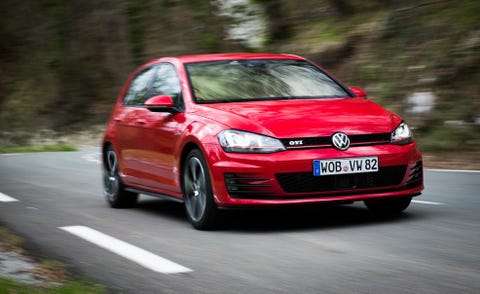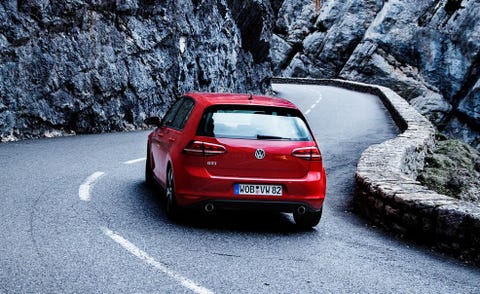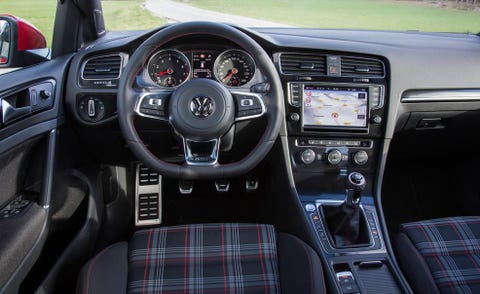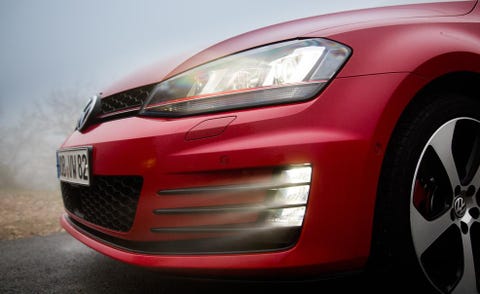From the July 2013 Issue of Car and Driver.
At roadside cafeterias in France, next to the napkins, cutlery, and plastic trays, are baskets of free dinner rolls. Hungry? Take as much as you want; bread is as free as air. We have to assume that this is a legacy of the French Revolution. No need to steal, Jean Valjean. The struggle is over. Everyone is equal and no one will go hungry. Put away the guillotine.
Parked outside the cafeteria is a 2015 Volkswagen GTI, the seventh generation of the hatchback that brought a taste of speed, in a dinner-roll-shaped package, to the common man. It’s not free bread, but it does represent a revolution. The super Golf was and remains the great egalitarian performance car, the first to so effectively combine power, economy, handling, practicality, and price. And, like all breakthrough ideas, it spawned imitators, all promising the same mix of virtues.
Volkswagen has not slacked off for its seventh GTI. A new platform called MQB is both lighter and stronger than before. At a glance, it does look a lot like its predecessor, but the metal is more tightly folded and the roof is lower. Longer in wheelbase and overall length by 2.1 inches, the GTI is within an inch in other dimensions. There’s more space inside, and the interior décor, while familiar, is also completely updated.
Power comes from the third generation of Volkswagen’s direct-injected, 2.0-liter turbo EA888 engine. Base versions bound for the U.S. will likely come with 210 horsepower (10 more than before) and 258 lb-ft of torque (51 more than before). With the addition of variable lift on the exhaust valves, the new engine is now similar in spec to the version Audi has been using in the A4 for several years. We’ll also get the optional Performance package that increases horsepower by another 10 ponies and adds an electronically controlled torque-vectoring differential, but not until late 2014. We drove a European Performance-package car alongside this test’s GTI and can report that no matter how imprudent you are with the acceleration, the differential holds the cornering line as if the car were tethered by an invisible string. But we opted for the standard Euro-spec car for this comparison because the wait for a GTI in the States is already long enough, and the conventional differential works quite well.
Parked next to the GTI is a Tangerine Scream Ford Focus ST. A staff favorite and 10Best winner, the 247-hp (Euro-spec) ST may be a GTI imitator, but it acts as if it’s running the Monte Carlo rally. It’s prepped to compete, too—no hatchback since the Lancia Delta Integrale has looked more ready for sponsorship decals. But the ST is not in France to run a timed stage. The ST is here because it was the only car able to vanquish the last GTI in our testing. So we filled our coat pockets with free bread and drove off to figure out which democratized performance ideology we’d prefer to follow.
Second Place: Ford Focus ST
Here’s something no one ever tells you: No matter how old you are, you’re going to mentally feel like you’re 19 forever. You won’t necessarily act 19, but in your head you’re still pretty much 19. And our inner teenager is smitten with the Ford Focus ST. The ST acts like it subsists on a diet of Mountain Dew Code Red and Totino’s Pizza Rolls. It is a bad-decision machine. It is, in a word, immature.
We mention the Ford’s youthful exuberance not to condemn it, but to define it. Quick steering (1.8 turns lock-to-lock) requires the reflexes of adolescence. Stomp the throttle, and the steering wheel yanks itself away from your hands, the wide 235/40R-18 tires struggling against the stampede of 247 horses that arrive during the temporary overboost.
Keep it pointed straight, and the ST will clip off a zero-to-60 time of 5.7 seconds and do a quarter-mile in 14.4 seconds at 99 mph. This European ST proved consistently quicker than the last ST we tested. We’re not really sure why; it could have been (a) the high-octane European fuel, (b) a particularly strong engine, (c) a thoroughly broken-in (7500 miles) example, or (d) all of the above.
A wall of noise accompanies any throttle application. Ford’s sound symposer pumps 85 decibels of 2.0-liter turbo party right into your ear at full throttle. The engine noise is inescapable. If cars could speak, we’re pretty sure the ST would say “dude” a lot. In addition to being loud, the ST is restless, and it never stops fidgeting. Stiff shock tuning transmits every subtlety of the road to the driver. The front-end grip is strong, even in tight corners, to the extent that you’ll usually find the rear tires sliding before the fronts break loose. Rain kept us from performing skidpad and slalom times—in our last test the ST clung with 0.93 g of grip.
The party never stops, but the ST itself can stop from 70 mph in 168 feet, which allows the ST to feign sobriety whenever an authority figure appears. The fact is that the ST is on perpetual spring break, forever trying to hoist you upside down to do a keg stand. Good times. But sometimes you just want to sip your beer out of a pint glass, like an adult.
A set of perfectly formed Recaros is basically the only concession to comfort. Like all Foci, the interior looks as if an F-117 stealth aircraft exploded inside. Angular bits jut out at the driver, and the front seat ends up feeling more cramped than the GTI’s. Material quality is good, but not quite the luxury-car-grade stuff in the VW.
We love that the ST exists. It’s like looking at an old yearbook picture of yourself. But while we sometimes like to think we’re 19 again, we’re actually not. Next to the GTI, the ST’s joys are fleeting. Ford has built a fountain of youth, but the effects are temporary.
First Place: Volkswagen GTI
The late David E. Davis Jr. was fond of asking, “Tony, what’s knocked your hat into the creek lately?” Mr. Davis knew full well that shock and revelation are rare in the car-reviewing business, but if you’d experienced something remarkable, he wanted to know about it. Well, Mr. Davis, the new GTI would have sent your chapeau sailing right into the drink.
There wasn’t much wrong with the last GTI. Okay, you couldn’t disable stability control, and recently it was not offered with summer performance tires. Despite the mandatory all-seasons, though, only one point separated the GTI from the victorious ST in last year’s comparison test. Having learned from that misstep, Volkswagen of America promises that when the new GTI arrives, it will come with the same Bridgestone Potenza S001 summer rubber worn by our European test car.
But it’s not the rubber or the now partially defeatable stability control that makes the new GTI remarkable. It’s the ease with which it does everything so well. The last GTI could multitask better than just about any car on the market. Comfortable on long drives, a firebrand on a back road, and marvelously utilitarian, the GTI was an A-student with varsity letters in three sports. But here’s what sent our hats aloft: From performance to practicality, every aspect of the new GTI is better than before.
It is a lot quicker. The acceleration is effortless; the turbo lag and torque steer are nonexistent, and there’s power everywhere on the tachometer. We were startled to discover that our 217-hp Euro-spec GTI took only 5.6 seconds to hit 60 and that the quarter passed in 14.2 seconds at 100 mph. North American versions may be detuned to 210 horsepower to deal with our lower-octane fuel but are expected to deliver the same 258 pound-feet of peak torque.
The latest 2.0T is a hot-buttered delight. The engine turns out 80 decibels of snarly music at full whack and is seemingly unfazed by the GTI’s 3057-pound weight— 121 pounds less than the last five-door GTI we tested. While the Ford’s engine remains in your face, the GTI’s four recedes into the background when you don’t want to hear it. The six-speed manual has light shift effort and is more precise than the ST’s. We didn’t flub a shift or crunch a synchro in more than 1000 miles of redline shifts.
A new variable-ratio steering rack that only requires 2.1 turns to go from lock-to-lock enlivens steering response. Slower on-center, the rack quickens near the extremes so that the GTI is dead stable on the highway but wakes up when you start throwing it into corners. Effort builds linearly in response to cornering pressure. Brake feel, a weakness in the previous GTI, is now Porsche strong. Stopping from 70 mph took only 159 feet.
Roll is tightly controlled; the strut front and multilink rear suspension is buttoned down, but the GTI remains lively and fun, even if, unlike the ST, it never indulges in tail-happy antics. Optional electronic dampers can be changed from supple to normal to ST jittery. Even when left in comfort, though, the shocks automatically tighten in response to chassis demands. Our models likely will get a simplified, two-stage version of these shocks as an option. The handling is unflappable, but high fidelity of the GTI’s chassis and controls keeps the experience thrilling.
A serious-looking, upright instrument panel faces the driver. High-quality and expensive-looking materials are consistently and tastefully applied. As in the new Golf, the center stack—complete with massive eight-inch multifunction screen—is canted slightly toward the driver. In the interest of cost cutting, though, our GTIs will have a smaller nav screen. We also won’t get an electric parking brake, but we’re fine with that—at least our GTIs will be able to do donuts in snowy parking lots. Otherwise, we’re promised an identical interior, plaid seats included.
The GTI wins because it can do everything the ST can do, only without the Everclear hangover. That’s another thing no one ever tells you: Part of being an adult is knowing when not to overdo it.
This content is created and maintained by a third party, and imported onto this page to help users provide their email addresses. You may be able to find more information about this and similar content at piano.io
Source: Reviews - aranddriver.com















